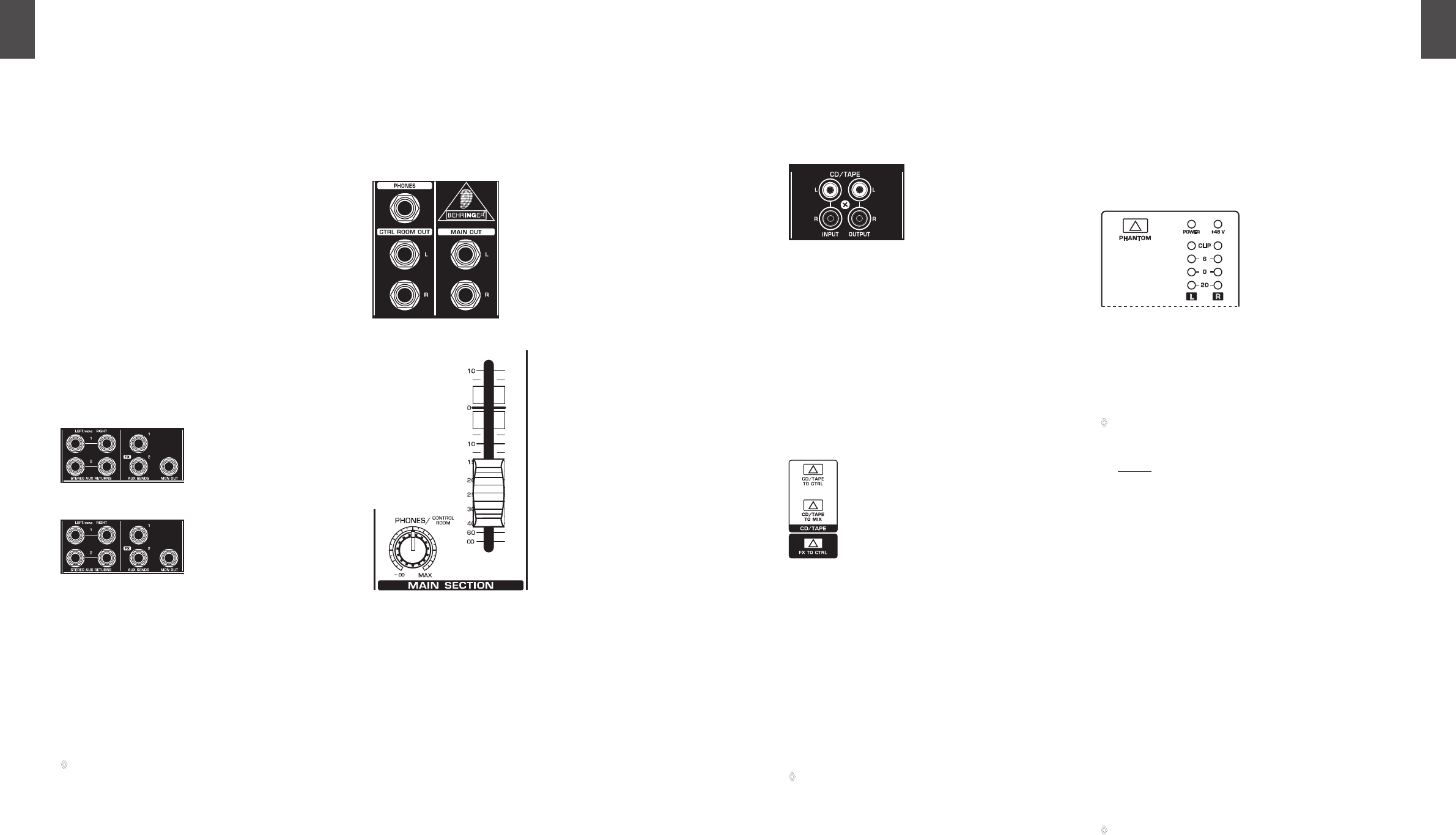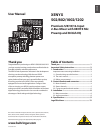
XENYX 502/802/1002/1202 User Manual
6
XENYX 502/802/1002/1202 User Manual
7
FX
The FX sends of the stereo channels function similar to those of
the mono channels. However, since the FX send buses are both
mono, a mono sum is first taken from the stereo input before it
is sent to the FX bus. The 502 is not equipped with FXsends.
BAL
The BAL(ANCE) control determines the levels of left and
right input signals relative to each other before both signals
are then routed to the main stereo mix bus. If a channel is
operated in mono via the left line input, this control has the
same function as the PAN control used in the mono channels.
LEVEL
The LEVEL control determines the volume of the channel
being sent to the main mix.
+4/-10
The stereo inputs of the XENYX 1002 and 1202 have an input
sensitivity switch which selects between +4 dBu and -10 dBV.
At -10 dBV (home-recording level), the input is more sensitive
(requires less level to drive it) than at +4 dBu (studio level).
Connector panel and main section2.3
Send/return effects path2.3.1
FX send/return connectorsFig. 2.7:
FX send/return controlsFig. 2.8:
STEREO AUX RETURN
802 only: the STEREO AUX RETURN connectors are used to
bring the output of the external effects device (whose input
is derived from the aux sends) back into the console. You
can instead use these connectors as additional inputs, but
any effects device will then have to be brought back into the
console via a normal stereo channel. This does, however, give
you the ability to use the channel EQ on the effects return
signal if you wish.
When using a stereo channel as effects return path, the ◊
FX control of the relevant channel should generally be
turned fully down to avoid undesirable feedback.
If only the left connector is used, the AUX RETURN
automatically operates in mono. Use the AUX RETURN control
to determine how much of the effects signal is sent to the
main mix.
FX SEND
The FX SEND output (does not apply for 502) should be
connected to the input of an external effects unit. The
post-fader FX signal you created using the input channel FX
controls is sent to the effects unit via the FX SENDouput. Use
the FX SEND control of the main section to adjust the overall
send level (1002 and 1202 only).
Monitor and main mix2.3.2
Monitor/main mix connectorsFig. 2.9:
Monitor control and main mix faderFig. 2.10:
PHONES/CONTROL ROOM
The stereo PHONES jack (at the top of the connector
panel) is where you connect headphones. The unbalanced
CTRL ROOM OUT jacks carry the summed effects and
main mix signals, as well as soloed channel signals. The
PHONES/CONTROL ROOM control adjusts the level of both
headphones and main monitor outputs. The 502 is not
equipped with control room outputs.
MAIN MIX
The MAIN OUT connectors are unbalanced mono jacks. The
main mix signal appears here at a level of 0 dBu. The MAIN
MIX fader adjusts the volume of these outputs. The XENYX
802 and 502 mixing consoles feature a rotary control for this
purpose.
CD/Tape connectors2.3.3
CD/TAPE INPUT
The CD/TAPE INPUTs are used to bring an external signal
source (e.g. CD player, tape deck, etc.) into the console. They
can also be used as a standard stereo line input, so the
output of a second XENYX or BEHRINGER ULTRALINK PRO
MX882 can be connected.
CD/Tape input/outputFig. 2.11:
Alternatively the line or tape output of a hi-fi amplifier with
source selection switch could also be hooked up here,
allowing you to easily listen to additional sources.
CD/TAPE OUTPUT
These connectors are wired in parallel with the MAIN OUT
and carry the main mix signal (unbalanced). Connect the
CD/TAPE OUTPUT to the inputs of your recording device.
The output level is adjusted via the high-precision MAIN MIX
fader or rotary control (802).
Signal assignment2.3.4
Assignment switches of the main sectionFig. 2.12:
CD/TAPE TO MIX
When the TAPE TO MIX switch is depressed, the 2-track input
is assigned to the main mix providing an additional input for
tape machines, MIDI instruments or other signal sources that
do not require any processing.
CD/TAPE TO CTRL ROOM (502: CD/TAPE TO PHONES)
Press the CD/TAPE TO CTRL ROOM/PHONES switch if you want
to monitor the 2-track input via the CTRL ROOM OUT. This
provides an easy way to monitor signals coming back from
tape to ensure that they are recording correctly.
If you are recording a signal via the CD/TAPE OUTPUT ◊
and wish to listen to this simultaneously via the CD/
TAPE INPUT, do not use the CD/TAPE TO MIX switch.
Doing this would create a feedback loop, since the signal
would be routed, via the main mix, back to tape via the
CD/TAPE OUTPUT. To monitor the CD/TAPE INPUT, use
the CD/TAPE TO CTRL ROOM switch to assign the tape
signal to the monitor(s) or headphones. This will avoid
the tape signal being routed to the CD/TAPE OUTPUT.
FX TO CTRL ROOM
If you want to monitor only the FX send signal in your
headphones or monitor speaker(s), press the FX TO CTRL
switch. This mutes the main mix signal while routing the FX
SEND output to the monitor(s). The XENYX 802 and 502 do
not feature this switch.
Phantom power and LED displays2.3.5
Phantom power and control LEDsFig. 2.13:
+48 V
The red +48 V LED lights up when phantom power is on. The
PHANTOM switch activates the phantom power supply on
the XLR connectors of all mono channels.
Please do not connect microphones to the mixer (or ◊
the stagebox/wallbox) as long as the phantom power
supply is switched on. Connect the micro-phones
before you switch on the power supply. In addition, the
monitor/PA loudspeakers should be muted before you
activate the phantom power supply. After switching
on, wait approx. one minute in order to allow system
stabilization.
POWER
The blue POWER LED indicates that the console is powered on.
Level indicator
The high-precision 4-segment display accurately displays the
relevant signal level.
LEVEL SETTING: To correctly set the gains of the channels,
first set the LEVEL controls of the input channels to their
center positions (0 dB). Then use the GAIN controls to
increase the input amplification until signal peaks show 0 dB
on the level meter.
When recording to digital recorders, the recorder’s peak
meter should not go into overload. While analog recorders
can be overloaded to some extent, creating only a certain
amount of distortion (which is common and often desirable),
digital recorders distort quickly when overloaded. In
addition, digital distortion is not only undesirable, but also
renders your recording completely useless.
The peak meters of your XENYX display the level ◊
virtually independent of frequency. A recording level
of 0 dB is recommended for all signal types.
























